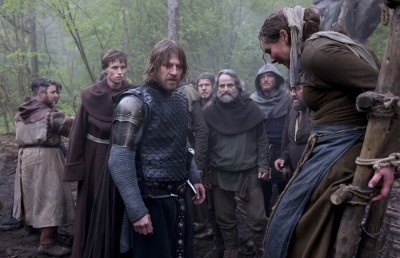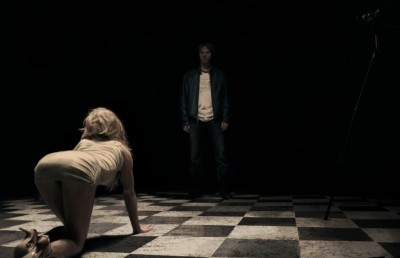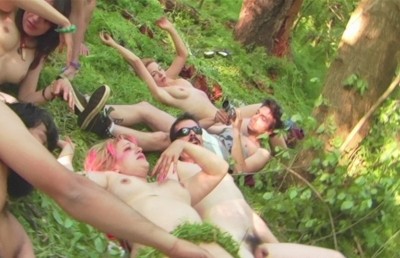An Interview With Ken Russell and Lisi Tribble
Rock n' Roller at Heart
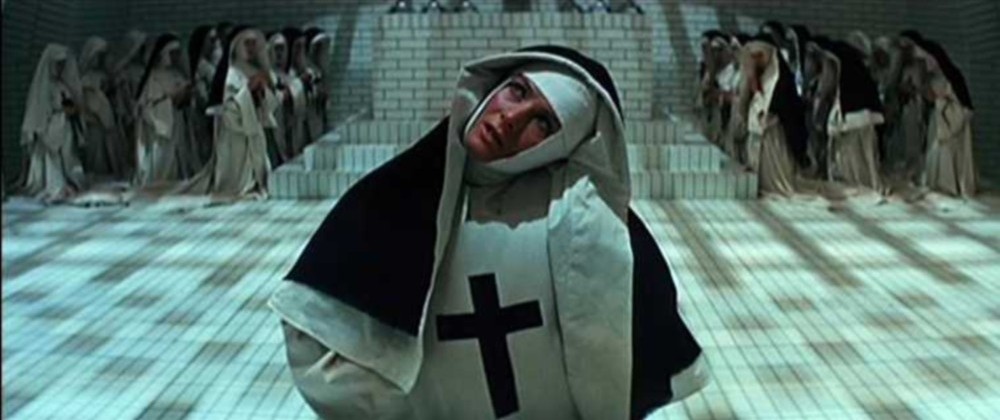
Ken Russell is a name that needs little introduction, as his contributions to British and world cinema from the late 1950s on has been remarkable, as much for the quality of the work as for the tenacity with which he carried on his unique ‘composite’ vision of art (never drawing specific lines between theatre, music, film, painting). Fantasia invited Mr. Russell to celebrate his work by presenting him with a Lifetime Achievement Award, on the night that his most notorious film, The Devils, received a rare Canadian screening (the intended 35mm print never materialized, due to ongoing ‘issues’ in North America with Warner bros, but instead a digital projection). Alongside this single screening at the festival, Montrealers were treated to a rare major retrospective of his films at the Cinémathèque Québècoise. The affable Ken Russell and his lovely wife Lisi Tribble were kind enough to meet up and grant Peter Rist and I some time to discuss his groundbreaking work. The meeting took place on July 20, the day after Fantasia screened his still remarkable film, The Devils.
Donato Totaro: I have a few general questions on The Devils and then a few ones regarding your career in general. I’ve read your autobiography The Lion that Roared and you have a really wonderful chapter on Powell and Pressburger. You seem to like their work. As a first question, were you at all influenced by Black Narcissus which treats a similar subject as The Devils, in terms of the representation of the nuns, the sexual hysteria?
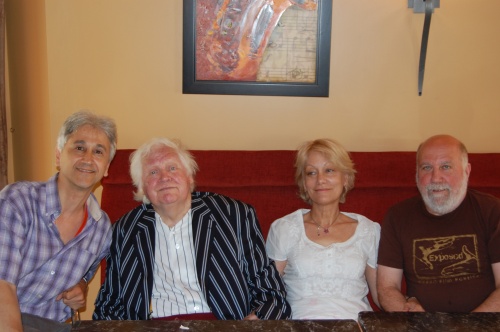
Totaro, Russell, Tribble, Rist
Ken Russell: I must say I saw it and liked it.
DT: Were any of their other films influential for you?
Lisi Tribble: What was the name of that one you like where they go to heaven….?
Peter Rist: Stairway to Heaven, which has another title, an original British title.
DT: A Matter of Life and Death.
KR: Oh yes.
LT: And you also liked that one with Wendy Hiller…..I Know Where I’m Going. You made me watch it.
DT: That’s interesting because that is the first British film which interjected fantasy. In the 1940s that was done in Hollywood, but to see it in a British film was quite striking, that interjection of symbolism, fantasy, into a realist context.
DT: Another thing you write about in your book is your conversion to Catholicism in the late 1950s, but a very personal form of Catholicism.
KR: Yes.
DT: Would you describe The Devils as a Catholic film?
KR: I suppose so.
PR: Not exactly positive depiction of Catholicism is it!
LT: It is about the heart of Catholicism. They way it has been distorted. Reve. Gene D. Phillips , [a professor of English and film at Loyola University of Chicago], a Jesuit priest , uses that film to teach Catholicism. He calls it a Catholic film, or a most Catholic film.
DT: There is a quote in a book by Thomas Atkins on your film, a small monograph on The Devils. Your personal Catholicism is described by him as “a cathartic value of sacrifice and the search for transcendence.” So the question of sacrifice is an important one to The Devils. So I guess that is one thing that makes it a Catholic film.
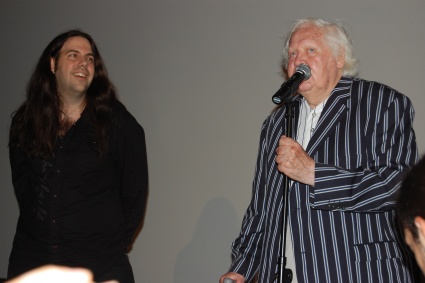
Russell Introducing The Devils, flanked by Mitch Davis
DT: Two of the filmmakers you say you like a lot in your book are Fritz Lang and Sir Charles Chaplin. Maybe this is something I am reading into the last shot of The Devils, you have a crane shot where the Madeleine character (Gemma Jones) scales and then walks down the dirt road, which is a lot like the ending of many Chaplin films.
LT: That is a good point.
DT: That must have been something you did not do consciously but subconsciously.
KR: Yes it was.
PR: There is also a visual Langian aspect as well to The Devils with the sets, which are amazing, by Derek Jarman. I was reminded as a kind of mix of Die Nibelungen and Metropolis, a kind of old and futuristic mixed together.
DT: Speaking of Jarman, what was a young Derek Jarman like to work with?
KR: He was a sort of kindred spirit. We had similar ideas and we complemented each other and helped each other out.
LT: I remember you telling me that Loudun would have been a new city it would not have had all that moss. That was part of the aesthetic, the white wall, and also the quote from Aldous Huxley [who wrote the non-fiction novel called The Devils of Loudun in 1952, ed.] about the rape of Sister Jeanne (Vanessa Redgrave): “The exorcism of Sister Jeanne was like an orgy in a lavatory,” which is why you wanted those white tiles.
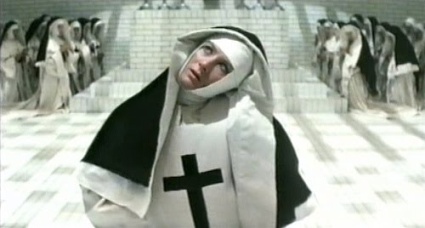
PR: Also the very low, semi-circular ceilings. Vanessa Redgraves’ performance was part of the design. She was extraordinary. She must have had fun on the set.
KR: Oh yes she certainly did.
DT: Her character has a hump. When she was performing with her clothes on did she actually have something on her back?
KR: Oh she had a hump to keep her in character.
PR: Do we ever see it?
DT: Yes in the dream sequence. We see it a lot more in the uncut version.
PR: How did Redgrave and Oliver Reed get along?
LT: The moment Reed as Urbain Grandier comes up and whispers to her, that is actually the first time they meet in the film. And that is very powerful. She sees her through the bars, in the street, she has a thing for him!
DT: Could you say that the Reed character somewhat of a rock star?
LT: That’s a good question. Well Ken you said that you first discovered him on TV show “Top of the Pops”.
DT: What was he doing on “Top of the Pops”!
KR: He was on the jury.
PR: Well he was in a musical…..
LT: ??Oliver!??….
PR: Bill Sykes. That was interesting too that you would cast him in the most positive role in the film, especially with his visible scar so accented, it is casting against type.
LT: When he auditioned for I think it was The Debussy Film, you told him “you are perfect, you could do that part.” And Oliver asked Ken, “what about the scar….”
KR: And I said, what scar!
DT: You made about 8 or 9 films with Oliver Reed.
LT: Yes that was his alter ego.
DT: Reed was known for having a rebellious off-screen nature.
KR: We had a method of working. Moody 1, moody 2 and moody 3.
LT. Oliver called Ken Jesus.
DT: How did you feel about that?
KR: I felt quite chuffed about it, but he would say, it is not a complement!
DT: That puts it in a perspective.
LT: I remember once he rode on the bonnet of your car, to stop you from leaving so you could have another drink. I presume you did.
DT: You might not remember these things you wrote in your book. You were writing about recent British horror films and you wrote about The Wicker Man.
KR: I like that film.
DT: It was made the same year or one year after The Devils. And it ends with a similar scene, with a man being burned, being sacrificed.
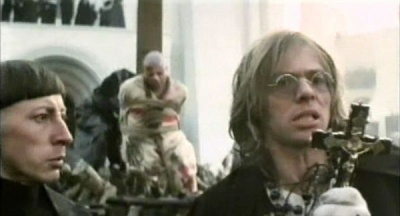
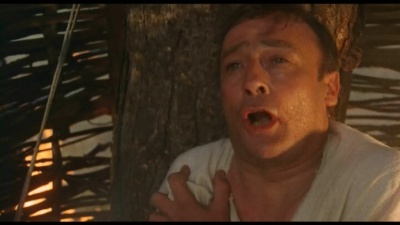
Sacrificial burnings at the end of The Devils and The Wicker Man
LT: It is a very British archetype, that comes out of that pagan mixture with Catholicism.
DT: If you are interested there is a wonderful documentary made in Canada by the NFB in 1990, The Burning Times, a fascinating historical look into witchcraft from the 15th century, the involvement of the church, gender, feminism and how it all grows out of that.
PR: It was nice when you introduced the film yesterday and you said, this film takes place maybe 500 years ago, or 400, or 300, or 100. I thought that was clever because you get lost in the period and you feel it can almost be contemporary.
KR: That is the thing. It is not a story that is going out of fashion. It is as relevant today.
PR: It seems to me there is this very strong connection in all of your works between film and rock and roll. You always have this very youthful approach to your material. You have these rebellious characters and you have this cult side to it which is like rock and roll. In my previous job I was teaching in London Ontario and was teaching this big genre course and one year we did the musical and we showed Tommy as an exam film. It worked very effectively as an exam film because of how students could find things they learned on the course in relation to it. It may not be one of your best received films but I’ve always liked it because we had such a very successful teaching of it. That is where you are a rock and roller.
LT: Well, Ken’s played guitar with Jeff Beck.
DT: Don’t tell me that! You’ve played guitar with Jeff Beck. He’s my idol! I’ve seen him live four or five times and kiss the floor he walks on!
LT: He’s the best.
DT: He’s actually born the same place as Peter, Croydon, and the same year!
LT: Come on!
DT: Can you tell us a little bit about that!
KR: She knows more about that than I do.
LT: There was this column for The Times, they said Ken and Jeff Beck, that’s a natural.
DT: Well yes because he is a rebel as well.
LT: Ken sang “Over the rainbow” and Jeff played it and then Jeff let you play his guitar so we had the two Stratocasters going.
DT: Do you actually play guitar?
KR: No, but I faked it.
PR: And one of the first films you made in 1959 made for TV, which I didn’t see, was called Guitar Craze.
KR: Oh yea, well there you go.
PR: Was that a documentary?
KR: Yes.
LT: And he also did the “ABC of British music,” other music documentaries like one on Donovan. But Beck was the high point. Because he is the best. And Beck was such a great guy. We were walking one day and we had just had car accidents this winter. And Beck says, I’ve had two car crashes and a plane crash.
DT: He was once laid out in bed out of it for about 18 months, close to dead.
LT: He said I know exactly where you are. And he told us the pilot of the plane that crashed crawled over his head to get out. Jeff has this amazing laid back, generous personality. He is a true artist.
DT: He has always said he much prefers to stay home to tinker with his cars and mope about with his cats.
LT: And he made his first guitar out of a cigar box and a rubber band. And Ken as a true rock and roller, got thrown out of the studio before we ever met him. Ken was saying, what do you mean I have to wait another hour to see him…forget this . And Jeff said, Ken…come in…come in. It was his handlers, not Jeff. They were really cute together.
DT: I’ve noticed a lot of critics, even the ones who were critical –and I hope you don’t hit me over the head with a newspaper , like you did once to Alexander Walker!– even the critics who don’t like your work, at the end they say there was something about the film that stuck with me, an image they can’t get out of their head, an idea…
KR: Sometimes they change their mind later….
DT: Pauline Kael did not like your work.
KR: She was cranky. She was interestingly perverse that way.
DT: Do you read the critics?
KR: Sometimes.
PR: I think it is other filmmakers who are more positive about your work. Like Scorsese.
LT: Yes when we were showing The Devils he was the only one with a copy and he got it out. There is a younger filmmaker, Bernard Rose, who asked Ken to be in his movie. John Landis asked him to be in his move but he didn’t give Ken a line so he refused.
DT: Are there any contemporary filmmakers you enjoy?
KR: Danny Boyle. And, maybe they are not young, but John Boorman and Nic Roeg, a friend too.
PR: You and Roeg are both real colorists.
KR: And Mark Locke who did a movie about a giant 7 foot tall boxing shrimp. Have you seen it? It is a one word title, a British movie [Crust, 2003].
DT: No, but I did see a recent British film called Death in Ventnor that had a character obsessed with lobsters. It is about this motley group of low level gangsters and the leader of the gang terrorizes his victims with a lobster.
KR: Now that sounds good. Ventnor and lobsters, have to see that.
PR: Talking about lobster or shrimp movies, there is Annie Hall, with Woody Allen trying to cook lobsters.
PR: It is amazing how prolific you’ve been up until about 2006 and then there is a gap and now you are apparently working on doing Moll Flanders. I noticed here that you did some Sarah Brightman videos. If you wanted do you could have become the greatest music director of all time…
LT: Tommy is the greatest music video of all time!
DT: And even Altered States has scenes in there that really have that feel.
PR: And the playful way you deal with serious art music, that is really special. I’ve always thought the material of your films is like what we get in art films, but you never make them like art films. You make these serious works with this popular, exciting, visceral approach.
LT: Ken always told me that he didn’t want his dad to change the channel in the first 60 seconds! So you had to start with a bang.
PR: That reminds me of when I was in NY University I used to work for the Art Council projecting films that were being judged and if the film didn’t have something interesting in the first 60 seconds….the jury all had a button and in 60 seconds they would press that button.
DT: Talking about art….You’ve made so many films on great artists. Is there an artist that you would have liked to have made a film on that for one reason or another you did not?
KR: I think mostly, the people I wanted to make a film on I ended up doing.
DT: You never did a film on Caravaggio. I could see you doing that!
PR: Derek Jarman did of course…
LT: I could quote that movie because I am so into Caravaggio. You did one on Henri Gaudier. That is my favorite.
KR: It is one of my best films. ??Savage Messiah??….and it is playing here.
PR: Could you talk a little about Moll Flaunders?
KR: That is never going to happen. Harry Towers was going to make it but he passed away so that is never going to happen. It was a Harry Allan Towers project but no more.
LT: He is directing something on Julia Margaret Cameron, the first female photographer. Her buddies were Lewis Carroll, and other various eccentrics. We are doing a short film on that. Ken is a ‘garagist’. He does films in his garage.
DT: I have a question on the music in The Devils by Peter M. Davis. How did that come about? Was it written all entirely before the movie?
KR: It was written to order, after the film. He did it in conjunction with the film after he saw the first cut.
LT: When Ken chose him to do the score he was unknown and had to fight for him.
DT: Well he has only done a few films, The Boyfriends and The Devils, that’s about it. So you really hand-picked him.
KR: Same with Derek Jarman, I met him on a train, and he showed him his portfolio.
PR: I was concerned when I learned last night that you were going to stay in the audience during the film because the Fantasia audience is notoriously crazy and we thought they might laugh at the wrong parts. But they didn’t. They were very good actually. It is a great audience, communal and you are a perfect guest for this festival because it is popular but always showing films that will have a minority audience so you fit into that real well.
DT: Did you enjoy receiving your lifetime achievement award?
KR: Yes very much. The award looked like a Michael Moorcock creature….
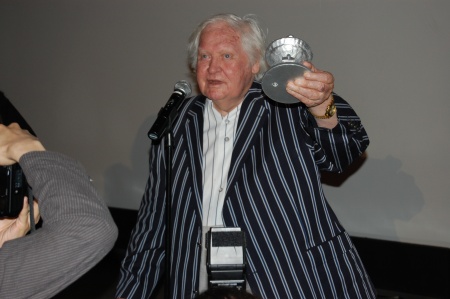
Russell receiving his award
DT: It was designed by an interesting local artist, Rick Trembles.
DT: I am interested in your approach to gothic, with The Lair of the White Worm and Gothic. What is it that attracted you to the whole gothic subculture?
KR: I guess the characters. The gothic contains very interesting characters . I can’t resist them in a way.
DT: Had you seen the Bride of Frankenstein which also has the prologue which recreates that wonderful night when the gothic fiction was created with John Polidor, Mary Shelley, and Lord Byron. And that also has a camp feel in the best sense of the word through the director James Whale.
LT: I know you were influenced by Monster of the Loch. That was Ken’s seminal horror film when he was twelve.
DT: Monster of the Loch, I’ve never heard of that. A British film?
KR: Yes.
LT: There’s a little diver who comes around and he finally sees the monster and what was the monster…
KR: A plucked chicken…underwater chicken. I got out of my seat and ran all the way home. I was five….
PR: What I remember from England and what struck me was the Quatermass Experiemnt, which was terrifying for me. We would talk about it at school and would never miss an episode but I think they have lost the episodes.
DT: Maybe we can conclude by talking a bit about the troubles The Devils has incurred, the cut version and the uncut versions. The scenes that were censored. Video Watchdog #35 has an in-depth breakdown and blow by blow account of everything that is missing in the cut version.
LT: Do they know why it is missing?
DT: Well it was censored, it was cut out.
LT: But the question that I don’t have the answer for is, why is it so frightening? Who is it frightening to?
DT: Well the moral watch guards. It is not so much what they fear but what they think will be offensive or too extreme for the mainstream.
At this point writer, editor and filmmaker Shade Rupe, who was escorting Russell and Tribble during their stay in Montreal and working quietly on his laptop on the table next to us, enters the discussion.
Shade Rupe: It is funny I got picked up at the airport by a Montrealer, Hubert, and he told me that people here don’t go to church anymore.
DT: That is not all true, a lot of the immigrants, like the Philippines are religious and go to church a lot. It is more the people who have been here for generations who have left behind the church, and there is a long historical-political reason for that of course.
DT: To get back to the question, I think what frightens people in terms of censorship is whenever you mar together sex and violence. The sequence that is cut of course is Redgrave licking the stomach wound which is very vaginal, and the rape of Christ sequence; as an interesting side story, we have a Montreal filmmaker Karim Hussain who was influenced by The Devils in his first film Subconscious Cruelty, in a scene where Christ gets raped with a tree branch. It is very very harsh, but very stylized too. Mitch Davis [Fantasia programmer] produced it.
Shade Rupe (addressing Lisi and Ken): The film didn’t have a big distribution. They chose to have a voice over and the minute a distributor hears VO, they go click. But the imagery in the film is quite remarkable.
LT: And Jesus of Montreal, that was great.
PR: Also in Montreal pornography was never really censored like in the rest of North American cities, but probably The Devils there would have been religious censorship rather than sexual.
SR: What I can’t understand is that Linda Blair can take a crucifix and repeatedly jab herself in her 12 year old special place and scream out “Let Jesus fuck you” and that’s groovy.
DT: Yes but she’s not a nun!
LT: Well she’s 12 years old. All 12 year old girls are nuns.
SR: It is strange. In Europe, Sitges festival for example, they have shown the new uncensored cut of The Devils. November 23, 2004 at the BFI in London, Ken was there, his editor Michael Bradsell, the technicians, Mark Kermode, it was a big event and then they sent the tape to the US and they said no. We are not going to release it.
DT: Well you heard about the uncut version being available as a digital download on itunes for 3 days, before being removed?
SR: Yes I know about that.
DT: Who leaked that? How did that get onto itunes?
SR: It was on schedule to be released and someone at some department at Warner Bros just uploaded it as a film. The art work is the same that was leaked a couple of years ago featuring that black and white image with Oliver Reed leaning back with the cross and Vanessa right in front of it. That was an actual piece of art work that Warner Bros had hired an artist to create; everything was going forward to release this movie, and someone, who won’t be named, pulled the plug. It is interesting because Tim Everett at Warner Bros UK was so helpful. The Lincoln Center in New York wanted to show this version, as did the American Cinematheque. I called Warner Bros and Tim said, “let me call Warner Bros and see what I could do.” He called me back and you could tell there was shaking in his voice and he wasn’t giving any names. I had to name the names until he just went ‘yes’. It is so mysterious. This guy that I had been talking to for months, who cut this film six years ago and who had digitized this footage they found, the one who led them into the vaults, all of a sudden he says, “That’s all I can really say”. Gosh it is only a movie!!! It’s not James Bond.
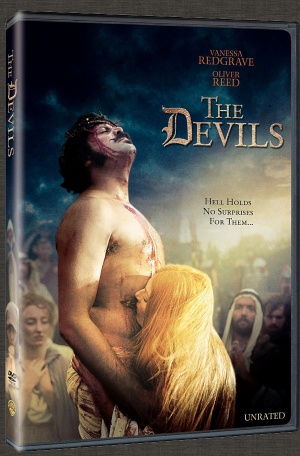
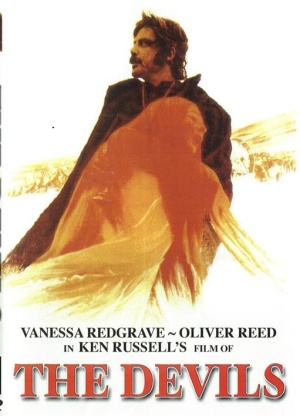
LT: There was a film canister with a note saying this film shall never see the light of day….at one point in time we had that information
SR: What did they think that all of a sudden all the churches all over the world were going to crumble.? The priest in the film is saying, I am a magician, I am a magician…when we see Louis VXIII turn that box upside down and it is empty, that is very powerful, and what kind of a game are you playing on us? And even Oliver Reed the lines that he gets, he’s playing all this.
DT: That is very similar to the moment in The Exorcist where the priest says that it wasn’t real holy water but the demon reacted as if it was. There must be someone high up at Warner Bros who is connected with someone high up in the Catholic Church.
SR: We think it is Allen Horn [president and CCO of Warner Bros] because the guy in the UK had no idea. If we were doing a festival in Europe they would let us use that tape. They even have a spare beta XP, but with all that Harry Potter billions in order for this screening to happen, Fantasia had to pay for this Digi Beta that Warner Bros owns.
DT: But we are Canada.
SR: In the US the American Cinematheque and Lincoln Center put money in because this one was made for Canada, so we had to get a special one for us. We tried to get a print made but didn’t have the time. What is surprising is really the amount of work they are putting into not showing the film. It is interesting if you look at the poster that Mitch chose to run in the program. Warner Bros’ own advertising campaign says: “The Devils should only –and the word only is in bold caps and italics– should only be seen by people who should see The Devils. It is like they only really want the 1300 people who are actually going to buy this to see it. Even 40 years ago the poster was mostly text apologizing for the film. Whereas throughout Europe they had that very large image of Vanessa screaming and Oliver standing and the soldiers in the background. “Hell holds no surprises for them.” And that was the same campaign used in Italy, Germany.
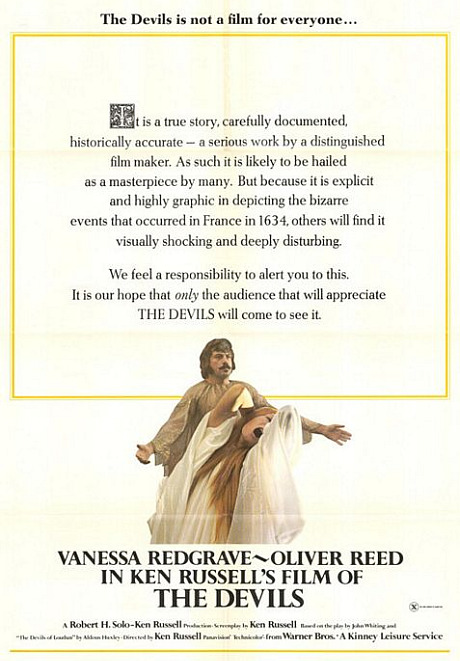
DT: And Italy is a Catholic country.
SR: It is interesting that Warner Bros has not released some kind of official statement on why they did not release the uncut version.
DT: I guess the truth on this will never come out. Peter and I want to thank you all for being so generous with your time.
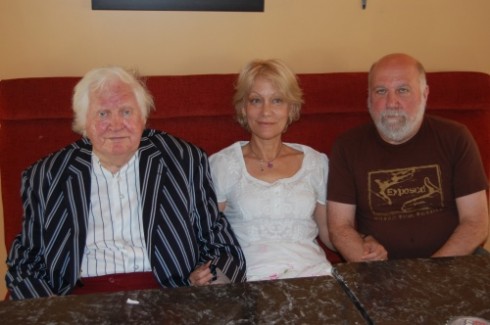
Russell, Tribble, Rist
All photographs property of author




